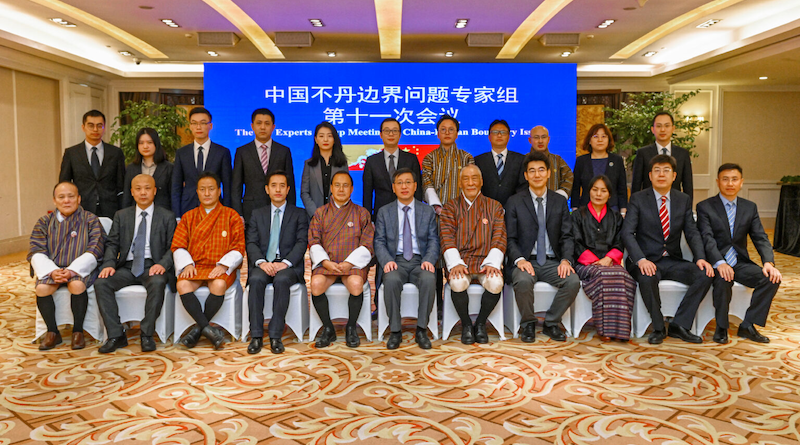China-Bhutan Border Talks – Analysis
By Institute of South Asian Studies
Bhutanese and Chinese officials engaged in the 11th round of Expert Group Meeting have agreed to “push forward” their boundary talks. However, it is hard to imagine Thimphu agreeing to any boundary-related deal with Beijing that concerns New Delhi.
By Amit Ranjan*
Bhutan and China had the 11th Expert Group Meeting (EGM) on their boundary issues in Kunming, China, from 10 to 13 January 2023. Dasho Letho Tobdhen Tangbi, Secretary of the International Boundaries of Bhutan, led the Bhutan delegation whilst the Chinese delegation was led by Hong Liang, Director-General of the Department of Boundary and Ocean Affairs of the Ministry of Foreign Affairs. The two sides exchanged views on implementing the Memorandum of Understanding (MoU) on the Three-Step Roadmap for expediting the boundary talks. They agreed to “simultaneously push forward the implementation of all the steps of the Three-Step Roadmap”. They also agreed to hold the 25th round of Bhutan-China boundary talks “as soon as possible at mutually convenient dates”. Both nations broadly focussed on two areas – Doklam and regions along the western borders of Bhutan lying near the India-China-Bhutan trijunction, and the Jakarlung and Pasamlung valleys in northern Bhutan.
China and Bhutan share about 477 kilometres of border. China claims around 764 square kilometres of land in Bhutan. The first round of boundary talks between Bhutan and China took place in 1984. In 1997, Bhutan’s foreign minister informed the Bhutanese National Assembly that during the 11th round of border talks with the Chinese delegation, the Bhutanese delegates put forward their country’s claims to Doklam, Sinchulung, Dramana and Shakhatoe in the western sector and stressed their importance for the people of Ha valley. They also informed the Chinese delegates that Tibetan herdsmen had been intruding into Majathang and Jakarlung in the central sector. At that time, China pointed to a package proposal made during the seventh round of talks in 1990 where they “had offered to give Bhutan the Pasamlung and Jakarlung valley, with an area of 495 square kilometres, in the central sector of the boundary if Bhutan agreed to concede in the western sector”.
In 2001, China came close to sealing the deal, but it failed. It is believed that India’s concerns made Bhutan refuse any compromise with China. In 2010, Bhutan and China agreed to hold a joint field survey of the disputed regions. The survey was completed in 2015. In 2017, despite ongoing talks, China started road construction near Doklam, leading to a military stand-off between the Indian Army and the People’s Liberation Army for 73 days. During that time, Bhutan accused China of unilaterally attempting to change the status quo in the Doklam region.
Post-Doklam, Chinese Vice Foreign Minister Kong Xuanyou visited Thimphu in July 2018. At that time, it is believed, that Bhutan kept India in the loop on the visit. In 2020, China widened its territorial claims in Bhutan by laying its claim on Sakteng in eastern Bhutan. On 14 October 2021, Thimphu and Beijing agreed on an MoU on the three-step roadmap for “Expediting the China-Bhutan Boundary Negotiation” via a video conference. The roadmap for the MoU was finalised during the 10th round of the EGM in April 2021 and was presented for approval by the respective governments. The MoU has not been made public and has only been exchanged between the two sides through diplomatic channels.
India is impacted by Chinese territorial claims and some areas are under dispute. China has strengthened its military connectivity in the Chumbi valley, which is between the Indian state of Sikkim and Bhutan. Chumbi valley is north of Doklam, while it lies on India’s Siliguri corridor in the south.
Some Indian analysts argue that if China gains control over Doklam, it might choke up the Siliguri corridor and cut off India’s northeast from the rest of the country during tensive times. The corridor is about 60 kilometres in length and 22 kilometres wide and connects New Delhi to the eight north-eastern states through road and railways communication. There are also media reports on the Chinese expansion of their model villages or Xiaokang (moderately prosperous) close to the Line of Actual Control, including in the Chumbi valley. Some Indian analysts have also expressed fear that the control over Doklam may make Kalimpong, which is situated in the Indian state of West Bengal, vulnerable. China has had Kalimpong on its radar for a long time. It is 100 kilometres from India’s border with Tibet in Jelep La and still has a Chinese and Tibetan origin population.
On the contrary, Harcharanjit Singh Panag, a retired Lieutenant General of the Indian Army and defence analyst, believes that choking India’s line of communication through the Siliguri corridor is not an easy task to do. It will require a major offensive attack by five to six divisions and further additional forces to stand against the Indian air power and counter-offensive strikes from the western, north-western and eastern flanks. Some Indian analysts also observe that India has an upper hand in the Chumbi valley because India has a strong force in Sikkim.
Although Bhutan is engaged in boundary talks with China, it is hard to envisage that Thimphu will agree on anything that concerns New Delhi.
About the author: Dr Amit Ranjan is a Research Fellow at the Institute of South Asian Studies (ISAS), an autonomous research institute at the National University of Singapore (NUS). He can be contacted at [email protected]. The author bears full responsibility for the facts cited and opinions expressed in this paper.
Source: This article was published by the Institute of South Asian Studies (ISAS)

